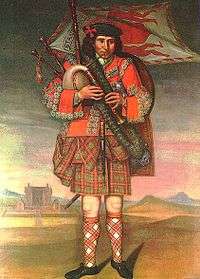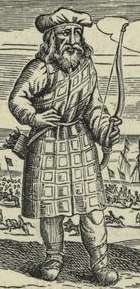Belted plaid

The belted plaid (or a plaid worn belted) is a large blanket-like piece of fabric which is wrapped around the body with the material pleated or, more accurately, loosely gathered and secured at the waist by means of a belt. Typically, a portion of the belted plaid hangs down to about the knees (for men) or ankles (for women) with the rest of the material being wrapped up around the upper body in a variety of ways and pinned or otherwise secured to keep it in place.
The belted plaid was a standard item of men's Highland dress from the late 16th century until the middle of the 18th century. It was also the precursor of the modern tailored kilt.
Terminology
| Pronunciation | ||
|---|---|---|
| Scots Gaelic: | féileadh-mór | |
| Pronunciation: | [feːləɣˈmoːɾ] | |
| Scots Gaelic: | breacan an fhéilidh | |
| Pronunciation: | [pɾʲɛxkan ə ɲeːlɪ] | |
The belted plaid has been and is often referred to by a variety of different terms, including féileadh-mór, breacan an fhéilidh, and, very commonly, the Great Kilt.
The term "Great Kilt" can be misleading since this garment was untailored, and modern era kilts are tailored. The garment was most definitely not known by this name during the years of its usage.
Both the terms féileadh-mór and breacan an fhéilidh are Gaelic terms, the former meaning roughly "large wrap" and the latter roughly meaning "tartan wrap".
The word plaide in Gaelic roughly means blanket, and that was the original term for the garment in question.
Description and History

.jpg)

The belted plaid consisted of a piece of tartan fabric approximately 4 or 5 yards in length and about 50 to 60 inches wide. Since the weaving looms in those years wove fabric in 25–30 inch widths, the actual item was generally constructed from 8 to 10 yards of such single-width fabric by stitching two 25–30 inch pieces together to get the 50–60 inch width.
It was typically worn as a kind of mantle or cloak cast about the shoulders. In the latter part of the 16th Century, some in the Highlands of Scotland began putting a belt around their waist on the outside of the plaid, after first pleating or gathering the fabric.
The first clear reference to the belted plaid occurs in the year 1594. In that year, a group of Highlanders from the Western Isles went to Ireland to fight under Red Hugh O'Donnell. Writing about them, Lughaidh noted how they could be distinguished from the Irish soldiers:
"They were recognized among the Irish soldiers by the distinction of their arms and clothing . . . for their exterior dress was mottled cloaks of many colours. . ., their belts were over their loins outside their cloaks."
A surviving woman's plaid dated 1726 exists (reconstruction, displayed worn as an earasaid).[1] A surviving men's belted plaid from 1822 has belt loops sewn into it at each pattern repeat, such that it can be rapidly pleated with a drawstring belt, or flattened entirely into a blanket.[2]
The belted plaid was used not only as a garment, but also as bedding at night, the wearer wrapping himself in it and sleeping directly on the ground.
It was made from wool or a wool/linen combination and twill woven, often in a pattern of coloured stripes in one or both directions. This gave a pattern of stripes or checks. The latter has today become known as tartan, though originally the word tartan referred to the type of cloth used, and not the pattern of colours as the word almost exclusively signifies today.
These tartan patterns (or Setts) were apparently chosen based on a sense of fashion or the availability and expense of natural dyes in the area of manufacture. The modern notion of "clan tartans" whereby each clan or name is associated with a particular design did not exist at that time, but instead dates back to the early 19th century. Thus, if one desires to wear the belted plaid at Highland Games, it would not be inappropriate (much less incorrect) to wear any tartan pattern of one's choosing or invention. In fact, not all such garments were woven in strict accord with the modern definition of tartan pattern.
The Kilt at Highland Games Today
At nearly every Highland Games gathering today there are vendors selling tartan items, whether tailored kilts, blankets, scarves, ties, or tartan fabric. By far the greatest proportion of their sales in the category of Highland dress are related to "modern" Highland attire, especially the modern tailored kilt and accessories for it.
This is somewhat ironic in that the present-day Highland Games, at which the modern tailored kilt is ubiquitous, can only trace their origins back to the early 19th century interest in matters related to Highland culture. (Note: this statement should not be construed to mean that the Highland Games themselves do not have antecedents going much further back in history.) This interest manifested itself in various reconstructionist events purportedly designed as a celebration of that earlier Gaelic Highland and Celtic culture, but such cultures never wore garments like the modern tailored kilt.
Instead, during the years preceding the Battle of Culloden, to the extent that Highlanders wore any kind of kilt-like garment, it was the belted plaid and not the modern tailored kilt. Yet the belted plaid is seldom seen at Highland gatherings today, and even knowledge of this garment is not widespread.
The origins of the modern short kilt (or feilidh-beag, meaning little wrap, and often Anglicized to philabeg with various spellings) are still debated. What is clear is that the philabeg originated from the belted plaid sometime in the early 18th Century, or perhaps somewhat earlier. The philabeg consisted essentially of the lower half of a plaid, gathered or pleated and held around the waist with a belt. Later, the gatherings were stitched down to hold them in place, and thus originated the modern tailored kilt.
Gallery images
-

Modern belted plaid, front view
-

Modern belted plaid, rear view
See also
- Earasaid
- History of the kilt
- Poncho, a garment that could also serve as a blanket.
References
John Telfer Dunbar, History of Highland Dress, Hippocreene Books 1979 (reprint of 1964 edition). (ISBN 0-7134-1894-X) The seminal book on the subject of Highland dress.
External links
- Men's and women's highland attire at Historic Highlanders
- How to wear the Sash at The Scottish Tartans Authority
- Hints and Tips for Scottish Country Dance - What to wear and how at Scottish Dance Net